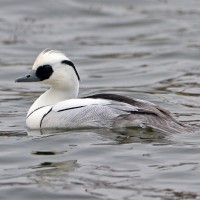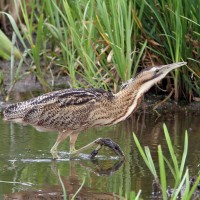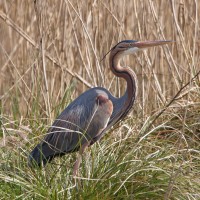Description
Polder Maltha is a great wetland area with a comfortable birding-hide from which you can see many different species: mainly herons, ducks, geese, raptors and Veliki vranac. In spring, Vodeni bik may be heard booming in the reeds, and ,again in spring and in summer, even Čapljica has been recorded on the many marshy islands with dense vegetation. In the last couple of years, a pair of Crvena čaplja has bred on one of the little islands. In winter, this area is often good for Veliki svračak. European beaver is also active in the area and with luck may be glimpsed at dawn or dusk. Another area of possible interest is the abandoned house when on the very end of the trail.
Lastly, a pair of Ribar (the first pair to ever breed in the Netherlands) has built a nest on one of the electricity pylons. Check the pylons to the east, the nest is located on the upper left branch of the electricity pylon. On spring migration, it is very much possible to see up to ten different Ribar here in a single day (I once saw nine here in just a couple of hours)! Making this one of, if not the best, area to see this raptor in the entire National Park.
_________________________
Nederlands: Polder Maltha is een van de beste plekken in de Biesbosch om watervogels en roofvogels te zien. Een geweldig waterrijk gebied met een comfortabele vogelkijkhut waar je veel verschillende soorten kunt zien: voornamelijk reigers, eenden, ganzen, roofvogels en Veliki vranac. In het voorjaar is Vodeni bik te horen, en opnieuw in het voorjaar en in de zomer is zelfs Čapljica waargenomen op de vele drassige eilanden met dichte begroeiing. In de afgelopen jaren heeft een paar Crvena čaplja gebroed op een van de kleine eilanden. In de winter is dit gebied vaak goed voor Veliki svračak. Bevers zijn ook actief in het gebied en met een beetje geluk kan een glimp worden opgevangen bij zonsopgang of zonsondergang. Een ander mogelijk gebied is het verlaten huis aan het einde van het pad.
Ten slotte heeft een paar Ribar (het eerste paar dat ooit in Nederland broedde) een nest gebouwd op een van de elektriciteitspylonen. Controleer de pylonen in het oosten, het nest bevindt zich linksboven op de hoogspanningsmast. Bij de voorjaarstrek is het heel goed mogelijk om hier op één dag wel tien verschillende exemplaren van de Ribar te zien (ik zag er ooit negen in slechts een paar uur)! Dit maakt dit een van de gebieden om deze roofvogel in het hele Nationale Park te zien.
Details
Access
From the visitors centre (Biesbosch museumeiland), which is easily reached from Werkendam take the Hilweg to the South, take a left onto Lijnoorden, follow this road for some 2 km. Park your car just in front of a small fence, which is the entrance to Polder Maltha, from there follow the trail until you reach the hide (on your right).
_________________________
Nederlands: Vanuit het bezoekerscentrum (Biesbosch museumeiland), dat vanuit Werkendam goed te bereiken is, neem de Hilweg naar het zuiden, sla linksaf Lijnoorden op, volg deze weg ongeveer 2 km. Parkeer je auto vlak voor een hekje, dat is de ingang van Polder Maltha, volg het pad tot aan de schuilhut (aan je rechterhand).

.jpg)


